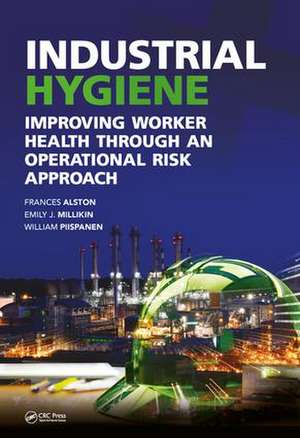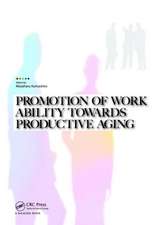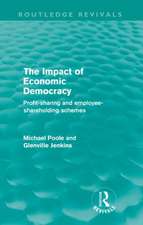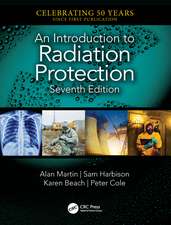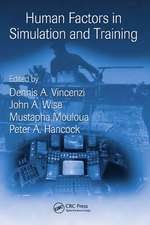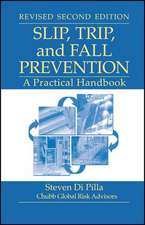Industrial Hygiene: Improving Worker Health through an Operational Risk Approach: Sustainable Improvements in Environment Safety and Health
Autor Frances Alston, Emily Millikinen Limba Engleză Paperback – 27 feb 2018
Features:
- Shows application of risk mitigating techniques for industrial hygienists
- Explains the definition of risk and how it applies to health and safety management
- Defines the need for quality data management and continuous improvement in assessments
- Describes the role of the Industrial Hygienist and risk management when responding to emergencies
| Toate formatele și edițiile | Preț | Express |
|---|---|---|
| Paperback (2) | 378.48 lei 3-5 săpt. | +19.85 lei 5-11 zile |
| CRC Press – 25 noi 2024 | 378.48 lei 3-5 săpt. | +19.85 lei 5-11 zile |
| CRC Press – 27 feb 2018 | 552.62 lei 6-8 săpt. | |
| Hardback (1) | 892.02 lei 6-8 săpt. | |
| CRC Press – 25 noi 2024 | 892.02 lei 6-8 săpt. |
Preț: 552.62 lei
Preț vechi: 741.00 lei
-25% Nou
Puncte Express: 829
Preț estimativ în valută:
105.76€ • 110.00$ • 87.31£
105.76€ • 110.00$ • 87.31£
Carte tipărită la comandă
Livrare economică 14-28 aprilie
Preluare comenzi: 021 569.72.76
Specificații
ISBN-13: 9781498773577
ISBN-10: 1498773575
Pagini: 198
Ilustrații: 29 Tables, black and white; 44 Illustrations, black and white
Dimensiuni: 156 x 234 x 13 mm
Greutate: 0.45 kg
Ediția:1
Editura: CRC Press
Colecția CRC Press
Seria Sustainable Improvements in Environment Safety and Health
Locul publicării:Boca Raton, United States
ISBN-10: 1498773575
Pagini: 198
Ilustrații: 29 Tables, black and white; 44 Illustrations, black and white
Dimensiuni: 156 x 234 x 13 mm
Greutate: 0.45 kg
Ediția:1
Editura: CRC Press
Colecția CRC Press
Seria Sustainable Improvements in Environment Safety and Health
Locul publicării:Boca Raton, United States
Public țintă
Academic and Professional Practice & DevelopmentCuprins
Chapter 1 Occupational Safety and Health in the Workplace Chapter 2 Art and Science of Industrial Hygiene Chapter 3 Industrial Hygiene Professional Chapter 4 Strategies for Exposure Monitoring and Instrumentation Chapter 5 Risk-Based Industrial Hygiene Chapter 6 Recognizing, Evaluating, and Controlling Workplace Hazards Chapter 7 Medical Monitoring and Surveillance of the Worker Chapter 8 Workforce Training on Hazard Recognition and Control Chapter 9 Industrial Hygiene and Emergency Response Chapter 10 Evaluating the Industrial Hygiene Program Chapter 11 Continuous Improvement
Notă biografică
Mr. Piispanen has 39 years of experience involving environmental health and safety programs. His career has included designing and managing both field engineering projects and research programs. Programs have included work place air monitoring, hazardous waste site investigations, incinerator source emissions, various energy systems emissions, semi-conductor manufacturing, and remedial action site construction. He has experience in the assessment and monitoring of a wide variety of hazardous chemical air contaminants and toxic metals, including conducted testing on explosives and chemical agent materials for military and civilian applications.
Mr. Piispanen has previous experience with biomass, fossil, and nuclear power systems plus evaluation of various air pollution and aerosol control systems. He has extensive field experience on a number of U.S. DOE sites conducting ESH assessments as well as experience working with the U.S. Navy on base closures and the U.S Army Corp of Engineers. He currently provides expertise and consulting support involving legal issues including OSHA citations, due diligence site assessments, and employee health and medical issues.
Mr. Piispanen is a graduate of University of Toledo (B.S.) and Washington State University (M.S.) with additional graduate studies at The Ohio State University and Northeastern University. He is a Certified Industrial Hygienist (ABIH), a Certified Ergonomics Associate (BCPE), a Certified Safety Professional (BCSP) and a Charter Member of the Institution of Occupational Safety and Health (IOSH). He also serves as a member of the ASSE/ANSI TC 262 on Risk Management/ISO 31000, is a member of the NIOSH NORA Construction Sector Council, and is a voting member on the ASTM E-60 committee on Sustainability.
Ms. Millikin has over 32 years of leadership experience in regulatory, environmental, radiation protection, and safety and health at Department of Energy (DOE) and Department of Defense (DOD) chemically and radiologically contaminated sites. She has served as the Director of Safety, Health, and Quality programs and managed all aspects of program, cost, and field implementation of Safety and Health, Industrial Hygiene, Radiological Control, Quality Assurance, Contractor Assurance System, Emergency Preparedness, Safeguards and Security, Occupational Health, and Price-Anderson Amendment Act Programs. Additionally, she has established successful employee-led behavioral-based safety observation programs and successfully achieved Voluntary Protection Program (VPP) Star status.
Ms. Millikin currently provides consulting services to the DOE Office of River Protection for the Hanford Waste Treatment and Immobilization Plant and Tank Farms Projects. She performs contractor oversight, and participates on integrated project teams, related to engineering and procurement, integrated safety management system (ISMS) and project readiness, safety and health, quality assurance, and industrial hygiene, including resolution of the Hanford chemical vapor issue.
Ms. Millikin earned a Bachelor of Science in Environmental Health in with double majors in Industrial Hygiene and Health Physics from Purdue University. She is a Certified Safety Professional, Safety Trained Supervisor, and certified in the National Registry for Radiation Protection Technologists.
Dr. Frances Alston has been effective in facilitating integration of ESH&Q programs and policies as a core business function while leading a staff of business, scientific, and technical professionals. She is skilled in providing technical expertise in regulatory and compliance arenas as well as determining necessary and sufficient program requirements to ensure employee and public safety, including environmental stewardship and sustainability. Dr. Alston also has extensive knowledge and experience in assessing programs and cultures to determine areas for improvement and development of strategy for improvement.
Dr. Alston holds a B.S. degree in Industrial Hygiene and Safety/Chemistry, a M.S. degree in Hazardous and Waste Materials Management/Environmental Engineering, a M.S.E. in Systems engineering/Engineering Management, and a Ph.D. in Industrial and Systems Engineering.
Dr. Alston is a Fellow of the American Society for Engineering Management (ASEM) and holds certifications as a Certified Hazardous Materials Manager (CHMM) and a Professional Engineering Manager (PEM). Her research interests include investigating and implementing ways to design work cultures that facilitate trust.
Mr. Piispanen has previous experience with biomass, fossil, and nuclear power systems plus evaluation of various air pollution and aerosol control systems. He has extensive field experience on a number of U.S. DOE sites conducting ESH assessments as well as experience working with the U.S. Navy on base closures and the U.S Army Corp of Engineers. He currently provides expertise and consulting support involving legal issues including OSHA citations, due diligence site assessments, and employee health and medical issues.
Mr. Piispanen is a graduate of University of Toledo (B.S.) and Washington State University (M.S.) with additional graduate studies at The Ohio State University and Northeastern University. He is a Certified Industrial Hygienist (ABIH), a Certified Ergonomics Associate (BCPE), a Certified Safety Professional (BCSP) and a Charter Member of the Institution of Occupational Safety and Health (IOSH). He also serves as a member of the ASSE/ANSI TC 262 on Risk Management/ISO 31000, is a member of the NIOSH NORA Construction Sector Council, and is a voting member on the ASTM E-60 committee on Sustainability.
Ms. Millikin has over 32 years of leadership experience in regulatory, environmental, radiation protection, and safety and health at Department of Energy (DOE) and Department of Defense (DOD) chemically and radiologically contaminated sites. She has served as the Director of Safety, Health, and Quality programs and managed all aspects of program, cost, and field implementation of Safety and Health, Industrial Hygiene, Radiological Control, Quality Assurance, Contractor Assurance System, Emergency Preparedness, Safeguards and Security, Occupational Health, and Price-Anderson Amendment Act Programs. Additionally, she has established successful employee-led behavioral-based safety observation programs and successfully achieved Voluntary Protection Program (VPP) Star status.
Ms. Millikin currently provides consulting services to the DOE Office of River Protection for the Hanford Waste Treatment and Immobilization Plant and Tank Farms Projects. She performs contractor oversight, and participates on integrated project teams, related to engineering and procurement, integrated safety management system (ISMS) and project readiness, safety and health, quality assurance, and industrial hygiene, including resolution of the Hanford chemical vapor issue.
Ms. Millikin earned a Bachelor of Science in Environmental Health in with double majors in Industrial Hygiene and Health Physics from Purdue University. She is a Certified Safety Professional, Safety Trained Supervisor, and certified in the National Registry for Radiation Protection Technologists.
Dr. Frances Alston has been effective in facilitating integration of ESH&Q programs and policies as a core business function while leading a staff of business, scientific, and technical professionals. She is skilled in providing technical expertise in regulatory and compliance arenas as well as determining necessary and sufficient program requirements to ensure employee and public safety, including environmental stewardship and sustainability. Dr. Alston also has extensive knowledge and experience in assessing programs and cultures to determine areas for improvement and development of strategy for improvement.
Dr. Alston holds a B.S. degree in Industrial Hygiene and Safety/Chemistry, a M.S. degree in Hazardous and Waste Materials Management/Environmental Engineering, a M.S.E. in Systems engineering/Engineering Management, and a Ph.D. in Industrial and Systems Engineering.
Dr. Alston is a Fellow of the American Society for Engineering Management (ASEM) and holds certifications as a Certified Hazardous Materials Manager (CHMM) and a Professional Engineering Manager (PEM). Her research interests include investigating and implementing ways to design work cultures that facilitate trust.
Recenzii
"...it could be a very useful primer for those wishing to know a little more about risk assessment and industrial hygiene than is generally avaliable."
The RoSPA, OS&H Journal, November 2018, pg 20
The RoSPA, OS&H Journal, November 2018, pg 20
Descriere
This book will distinguish itself because it integrates risk management techniques into managing and protecting workers and the public. The application and integration of risk into the implementation of an IH program has not been addressed in detail in previous books to the extent of how the two programs can be effectively used.
